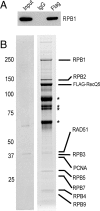A RECQ5-RNA polymerase II association identified by targeted proteomic analysis of human chromatin
- PMID: 18562274
- PMCID: PMC2430918
- DOI: 10.1073/pnas.0804424105
A RECQ5-RNA polymerase II association identified by targeted proteomic analysis of human chromatin
Abstract
Although the active forms of factors involved in DNA-related processes such as DNA replication, repair, and transcription are associated with chromatin, proteins are rarely purified from this source. Here, we describe a protocol for the isolation of chromatin-associated factors and use it to identify proteins interacting with human RNA polymerase II (RNAPII). Our data establish RECQ5 helicase as a bona fide RNAPII-associated protein. The RECQ5-RNAPII interaction is direct and is mediated by the RPB1 subunit of RNAPII, and RECQ5 appears to be the only member of the human RECQ family of helicases that associates with RNAPII. These data suggest an unexpected role for RECQ5 helicase at the interface of transcription and genomic stability.
Conflict of interest statement
The authors declare no conflict of interest.
Figures




References
-
- Maldonado E, et al. A human RNA polymerase II complex associated with SRB and DNA-repair proteins. Nature. 1996;381:86–89. - PubMed
Publication types
MeSH terms
Substances
Grants and funding
LinkOut - more resources
Full Text Sources
Molecular Biology Databases

